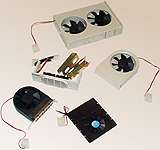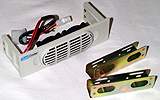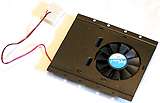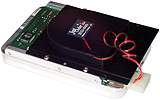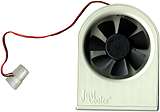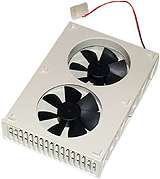
Just Cooler PC cooling fans
Review date: 28 September 1999.Last modified 03-Dec-2011.
These "Just Cooler" fans are made in Taiwan, and resold, sometimes under different names, by various computer stores and Web dealers, including my own sponsors here in Australia, Aus PC Market. You can get some or all of these fans from, for instance, 3DCOOL and 2CoolTek, for reasonable prices.
All of these coolers except for the HD-100 are ducted models; the fan moves air through some kind of moulded housing. Ducts are good, because they let you put air right where you want it, instead of blowing lots of air around things that don't need it. But ducts are bad, because they reduce the air-moving ability of the fan.
Fans move the maximum amount of air when they're completely unhindered by housings or grilles - the "free air" situation. Any actual real world situation won't be completely free air, but some come close - a plain desk fan, for instance, which only has to blow air around its wire safety guard. Computer fans are usually choked by more-steel-than-hole grilles, and the efficiency of most front-of-case fans is further reduced by really badly sealed mounting cradles, that let air leak around the fan and make it stir the air inside around more than it exchanges it with the air outside. But with care and a bit of hacking, you can greatly increase the air moving capacity of a regular unducted fan; see my project here for the lowdown.
The coolers
Hard drives get hot. You can't get around it. There's air in there, surrounding and rubbing on the rapidly rotating platters, and friction makes heat.
5400RPM drives run relatively cool, and seldom need any sort of special cooling, even in cases with awful ventilation. 7200RPM drives are significantly hotter, and if you live in a warm climate or have multiple drives hard up against each other, extra cooling is a good idea. 10,000RPM drives pretty much all need extra cooling in just about any situation, to keep them reliable. They may work for ages just sitting there baking away, but if you've just shelled out a slab of cash for the latest 10,000RPM SCSI monster, another few bucks for a cooler is cheap insurance.
Which brings us to the two Just hard disk coolers. Let's look at the boring one first.
HD-100
The HD-100 is your standard front-of-bay cooler. It mounts in the front of a 5.25" drive bay, it's got adapter rails so you can park a 3.5" drive behind it, and it's got two dinky little 40mm fans that can blow or suck - you can pry them off their little mounting pegs and turn them around. There's a removable foam dust filter, and the whole thing costs about $30 (Australian dollars) from a non-rip-off dealer.
These sorts of coolers don't move a lot of air. They use slim-line 40mm fans, which are each good for about 5.4 cubic feet per minute (cfm) of airflow. Then again, two or three of them banked together make a decent breeze, and assuming you've got them set to blow the air into the case, the drive will get the benefit of all of it. The slight suction created by even one standard fan blowing out of the case will help the cooler along a little, and it should actually work fine.
But it just ain't sexy.
HD-600
Enter the far more interesting HD-600, which retails for $35 Australian. This exceedingly slim-line fan screws to the underside of any 3.5 inch drive, and adds only a tiny bit to its height at the mounting-rail sides, so it should still be mountable anywhere it could be mounted before, as long as there's no other drive directly under it to foul the bulge with the fan in it.
In a regular case with three 3.5 inch drive bays, this means a drive with an HD-600 screwed onto it can be mounted in any bay you like, as long as no drive is mounted in the bay right under it. If you've got one hard drive and one 3.5 inch floppy drive this gives you a few options; if you've filled all three bays, only one drive can have an HD-600 on it, and it's got to be mounted in the bottom bay. You can always use adaptor rails and put your 3.5 inch drives in 5.25 inch bays, of course, but then you could just as easily use a regular cooler like the HD-100.
Mounting the HD-600 is easy enough, using the included (somewhat lopsided) screws, and there's a handy passthrough connector on the cooler's power lead, which you can plug into the hard drive's own connector. Mounting the drive with cooler into the case is no trickier than mounting a bare drive.
The HD-600 moves a limited amount of air. The manufacturers claim 18cfm at 3500rpm, but since this is roughly what you can expect from a higher-revving 60mm full-thickness fan spinning in free air, I doubt the skinny ducted fan in the HD-600 actually achieves such performance. It's got lots of nifty-looking tilted blades, but 18cfm still seems rather high. Maybe it does 18cfm when it's hanging in space, but it doesn't seem up to it when it's mounted on a drive.
That said, it does indeed cool a hard drive perfectly well. It's impossible to tell whether a drive in a 3.5 inch bay with an HD-600 on it will run cooler than one in a 5.25 inch bay with a conventional cooler blowing air past it, because the whole case airflow changes when you add a 5.25 inch bay cooler. I suspect the conventional cooler would win, in most cases, because it's sucking fresh air from outside. But the HD-600 seems to do a perfectly adequate job, and should be up to the task of cooling a 10,000RPM drive, provided your overall case ventilation is OK and the HD-600 is not just pulling hot air past a hot drive.
FC-100
This is a "slot fan"; it screws into an expansion slot hole on the back of the computer. It doesn't plug into a slot on the motherboard, just a lead from the power supply, but it nonetheless takes up a slot; you can't install a card in the slot you pick for the fan. It costs $25 Australian.
With a respectable 80mm fan on it, the FC-100 is touted to have 32cfm airflow at 2800RPM. Maybe it does, I don't know, but again I suspect the number's somewhat inflated. 32cfm is about the same performance as an 80mm 12V fan running free-air, and this one has ducting and a grille.
The FC-100 blows a respectable breeze, whatever its real stats, and it should do a decent job of hauling air out of the case. It's clipped onto its mounting plate, which means a bit of levering with a screwdriver will allow you to reverse it and point the inlet side at the hot card of your choice. You don't have a choice about which way the air moves, though; the FC-100 only blows out.
If you've already got decent case ventilation and the air in the case is thus reasonably cool, the FC-100 will do a good job of keeping the heat out of adjacent cards, and help overall airflow. If your case ventilation ain't so great, though, a slot fan will just be labouring to draw hot air out, and won't help nearly so much.
HD-300
This is a rarer beast - it's a slot fan for the front of the computer. The HD-300 is essentially much the same as the FC-100 (and costs the same - $AU25), but it mounts in a 3.5 inch drive bay, and blows air out the front of the case, directing it downwards with a baffle. The makers claim the same airflow as the FC-100. It probably does get about the same performance, whatever the FC-100's real performance is, provided it's not got a drive mounted hard up against its upper-side intake.
But that baffle has me, well, baffled; it blows the warm air down, which means on pretty much any tower case it's blowing it towards the main front air intake. When air conditioning systems are built like this, people catch Legionnaire's Disease. In this case, all you're going to do is sacrifice a bit of cooling efficiency.
As a less elegant alternative to the HD-600, with greater airflow, the HD-300 might well cut it just fine. But it can't move a ton of air with a drive right next to it, and some of the air it does move is likely to come back shortly. So I can't say I'm hugely impressed with this particular product.
Twin Turbo
Now you're talking. This thing mounts in, and fills up, a 5.25 inch bay. It's got a pair of 90mm fans, mounted to feed a pair of ducts leading to the front. You can mount the Twin Turbo either way up, to draw air past a drive above or below it, but you again have no choice about the airflow direction; it only blows out. To avoid drying the eyeballs of the user, the front of the Twin Turbo has louvres which squirt the air to the right or left, depending on which way up you've mounted it. It costs $49 Australian.
The manufacturers claim 80cfm airflow from the Twin Turbo, which again sounds to me like a free-air kind of figure. In the housing, and especially hard up against some drive or other, the actual airflow is likely to be a lot lower. But, again, fantasy numbers aside, a goodly amount of air gets moved.
The only thing to look out for with the Twin Turbo would be an airflow "short circuit"; if most of your air is entering at the bottom front of your case, and the Twin Turbo is removing most of what enters through the top front, the motherboard may not get a whole lot of airflow. If your case has a decent number of other vents, though, this shouldn't be an issue.
Various sites that sell the Twin Turbo like to tout it as the best PC cooler ever made, blah blah. Well, it's probably the best you can buy over the counter, but it don't beat my option.
Overall
All of these coolers, except perhaps the HD-300, have their place. They're decently made, not too expensive (provided you're not buying from somewhere that puts their own sticker on and adds 50%), and do the job. They also run quietly; smooth edges on the plastic mouldings have to help with this, as well as the very nature of ducted fans, which puts the buzzing fan blades out of line of sight and thus helps attenuate the noise.
The HD-600 is exceedingly groovy, and the Twin Turbo is, indeed, probably the most cooling you can buy off the shelf. But none of these coolers, if you'll pardon the expression, suck.
